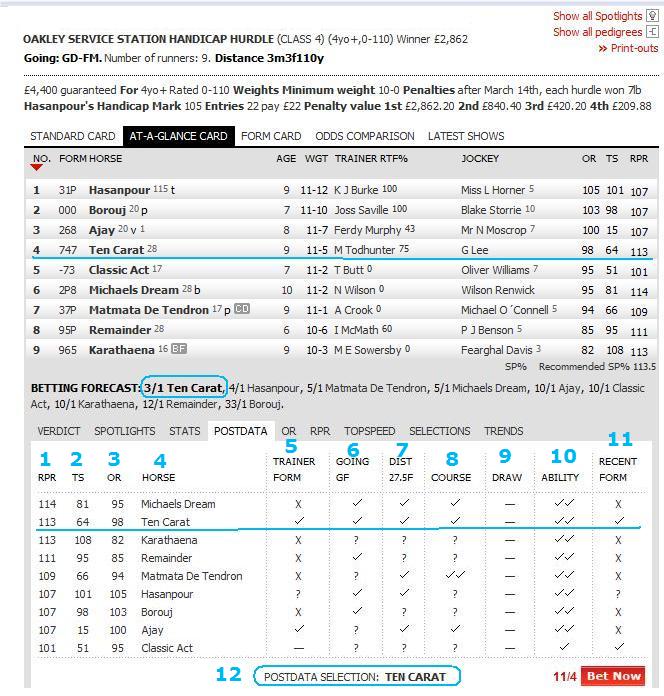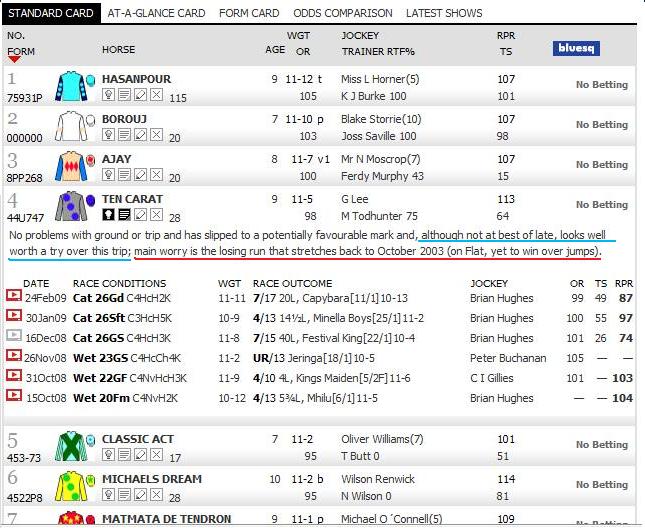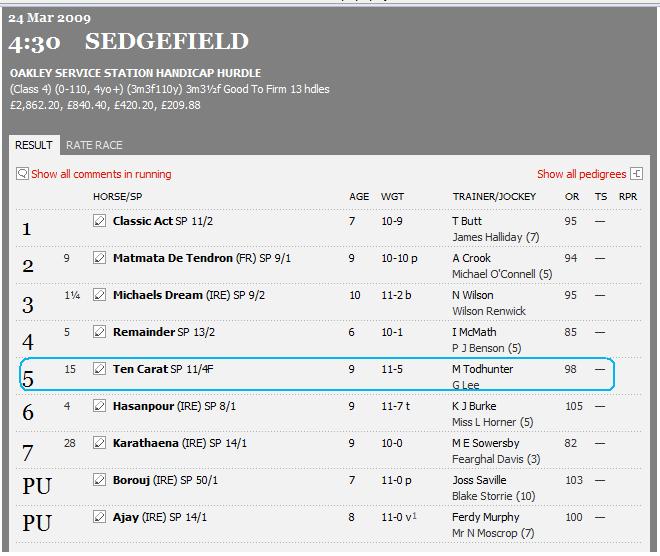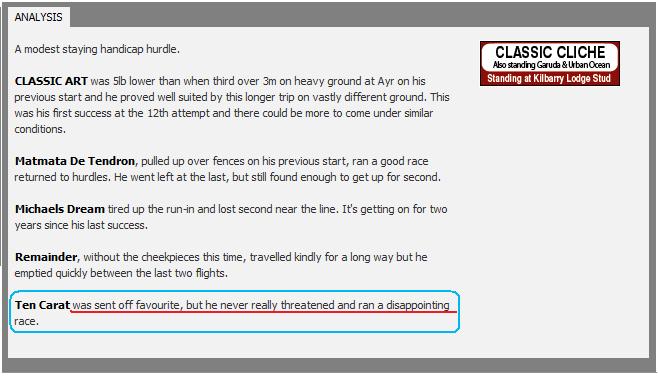Why following Racing Media tips is a losing habbit & (what YOU can do about it)
November 17, 2011 by Jonathan
Filed under Horse Racing, Recent Articles
The “POSTADATA TABLE” in the Racingpost is one of the mostwidely used betting resources, by punters in the UK. In this tutorial we assess its accuracy, and reveal why it often pays to take the opposite view to the National Newspaper tipsters.
The Racing Post website provides some of the most innovative race assessment tools available to the modern form reader. Probably the most useful tool they provide is the Postdata Table, which is designed to compare the abilities of each horse, based around various bench mark ratings applied by the professional race readers.
The core idea behind the Postadata table is to allow form readers a quick way of assessing and comparing the overall abilities of runners contesting a race. The highest RPR (Racing Post Rated) horse is at the very top of the table, followed by each runner in descending order.
In order to use the Postadata Table efficiently an explanation about what all the factors actually mean is needed. We feel its best to explain everything in the context of an actual race. Then you can see the theory in reality. Ultimately this tutorial will help you to cut through the media hype when trying to identify false favourites.
Firstly, lets look at what all the information on the Postdata table means.
Types of ratings
Three types of rating can be found across the Racing Post site.
1. Racing Post Ratings
2. Topspeed ratings
3. Official Rating – BHB ( Official Rating – British Horse Racing Board ) ratings
1. Racing PostRacing Post Ratings (RPR) are merit ratings produced by a team at the Racing PostRacing Post and are based on collateral form i.e. if horse A beats horse B carrying the same weight then it will be awarded a higher rating. The ratings are expressed in pounds (lb) so a horse rated 140 is regarded as 10lb better than one rated 130. There is amore or less accepted sliding scale for converting lb to distance where 3lb = 1 length over 5f and 1lb = 1 length over 2m and upwards
2. Topspeed ratings are based on race times so horses recording faster times will achieve higher ratings. The ratings are measured in pounds like RPR and aim to remove the effect of different going and weather conditions on the race times.
3. Official ratings use the same principles as Racing PostRacing Post Ratings, but are compiled by a team working for the British Horseracing Board (BHB) and are used to determine the weights horses will carry in handicap ratings. In contrast to RPR the BHB rating found for horses in results reflect the horses’ ratings going into the race not what they achieved in the race.
4. Horse’s name
There are also seven other form factors considered. These’ all relate to a horses ability.
5. Trainer form
An assessment of the trainers trainer’s recent form.
One tick…………Trainer in form
Two ticks……….The trainer is in great form
?…………………….The trainer’s form is questionable
– …………………….The trainer is currently out of form
X…………………….The trainer has had no runners in the last two weeks
6. Going
A Study of the horse’s ability on the forecast going.
One tick…………The horse has confirmed ability on the going or similar.
Two ticks……….The horse has confirmed ability on the described going.
?…………………….The horse has not confirmed its ability on the going
– ……………………This means it is the horse’s first race on described going
7. Distance
Analysis of the horse’s capacity to cope with the distance of the race
One tick………..The horse has confirmed form at this distance
?……………………The horse has not confirmed form at this distance
-…………………… Means it is the horse’s first time racing at the distance
8. Course
Analysis of the horse’s ability to handle the racecourse.
One tick ………..The horse has confirmed form on this course i.e. (Run at course and placed in the first 3)
Two ticks ………The horse has won twice or more at the course
? ……………………The horse is unproven on the course
– ……………………The horse has never raced at the course before
9. Draw
Analysis of the draw bias at the course
(Flat races under a mile usually; there are no stalls for National Hunt racing.
One tick ………..The horse has a good stalls position
Two-ticks ………The horse has first-rate stalls position
X …………………….The horse has a poor stalls position
– …………………….The horse has a neutral stalls position.
10. Ability
Analysis of the horse’s ability or potential to compete.
One tick …………The horse has some OK form this year
Two ticks ……….PM or TS rating within 7lb of PM top achieved within last 60days
Three Ticks…….Both PM and TS are good
? …………………….The horse last raced more than 60 days ago
X ……………………The horse has no satisfactory form within last 60 days
-……………………..The horse has never raced at the course before
11. Recent Form
Evaluation of the horse’s most recent form.
One tick …………The horse has some confirmed form within the last 2 months
Two ticks ……….PM or TS rating achieved within last 2 months
?……………………..The horse’s last race was more than 2 months ago
-……………………..The horse has never run a race under rules before
12. Is the horse that has highest combined score on the Postdata Table.
Take your betting the next level
Most tipsters would opt out of putting up a selection in a large number of races
Now you have a better understanding of what all the Postdata information means let’s take a look at some of the myths surrounding how to interpret the various factors using the above Postdata Table selection TEN CARAT.
This example will illustrate that, although professional race readers are very knowledgeable they have to make judgements, and provide tips for every single race. Ultimately they get paid for their race assessment services, and in many instances their tips are so over bet by the punting masse`s they are simply not profitable to follow.
It is a little known fact that most Media & National newspaper tipsters would willingly opt out of putting up a selection in a large number of races. However, that is not an option. That’s the nature of the job. If you would like to see for yourself how most of these tipsters perform, take a look at the Press challenge Table on the racing Post website
Not only was TEN CARAT the Postadata selection, it was also the Racing Post forecast favourite, these two factors combined often means that the majority of punters will think that the horse is a good thing and potentially lump on it, thus reducing the price. That in my opinion is good news for false-favourites system users because it provides the knowledge to see through the hype. Remember obtaining value, and selectively taking the opposite view to the so called professionals is they key to long-term success.
Looking at the horse form in more detail we can see that this horse clearly doesn’t have that much ability. Its last 6 races read 7,4,7, UR,4,4
Its Spotlight verdict reads…
No problems with the ground and trip and has slipped to a potentially favourable mark, and although not at the bets of late, looks well worth a try over this trip; main worry is the losing run stretches back to October 2003 (on flat yet to win over jumps)
Key words to pay attention to here are:
Although not at best of late
Looks well worth a try over this trip;
Main worry is the losing run stretches back to October 2003 (on flat yet to win over jumps)
The profile of this horse looks pretty poor overall and doesn’t inspire at all. In fact this is exactly the kind of favourite that serious backers would avoid at all costs.
Summary
TEN CARAT`S last 3 races read 7,4,7, it had been dropping in the handicap but its spotlight comments were negative. Furthermore, the horses last six races showed it hadn’t even placed in 3 months. That combined with the fact that it hadn’t won for 6 years meant it looked a pretty useless horse.
Probably the main reason that TEN CARAT was a Postdata selection, and the Racing Post favourites was because this race looked weak and rivals were thin on the ground. Although looking at the RPR `s of all the horses collectively, it did appear to be more competitive than first glance suggests, i.e…
114-101 -5 horse in between 114-109 (only 5lbs difference)
The betting forecast tells us a story in its self with the first 4 being priced in percentage terms – 3/1, 4/1, 5/1, 5/1
Some of the other horse had an even better recent form than TEN CARAT, i.e. HANSPOUR 31P, CLASSIC ACT -73
Lets take a look at the result:
My pre-race analysis proved to be correct. TEN CARAT was sent off as favourite because it was probably backed in droves by the punting masses. The fact it was a Postdata selection, and a RacingPost forecast favourite would have increased the likely hood of it odds shortening. Here`s the confirmation of my lay bet…
The above example is taken from the Race Specialist laying manual. I have identified many Postdata lay selections using the methods described in the book. I would love to include more in this post, but unfortunately there just isn’t the space to do this.
Postdata table (key facts awareness)
- The In running race comments tell us that this race was a “Modest staying handicap hurdle”. TEN CARAT never threatened and ran a disapointing race.
- Frequently the Postdata Table proves to be an accurate assessment of a horse’s chances, but you should never lose sight of the fact that the race readers have to view a lot of races each day. They can not possible spend more than a few minutes on each race.
- It is a little known fact that most tipsters would willingly opt out of putting up a selection in a large number of races. However, that is not an option. That’s the nature of the job. If you would like to see for yourself how bad most tipsters actually are, simply look at the Naps Table in the Racing Post, since they get paid to tip in every race.
- A tipsters/race- reader’s evaluation of a particular horse may prove informative, but it is by no means completely accurate when put into the context of the current race.
- Any decent performance a horse achieved in the past won’t necessarily mean that it will repeat that performance in the future as those past successes are often achieved under different circumstances than the current race under assessment. Even slight differences can make a difference. After all, we are dealing with living creatures, (not machines,) which can be difficult to define in consistency terms.
Assess the facts not the hype!
The following information is designed to get you thinking outside the box. Remember, the Racing Post is on the walls of every betting shop in the UK. All the obvious information can easily be found by the punting masses, and is unlikely to be profitable.
A combination of tips and media hype cause serious over betting on false favourites. which is good news for the serious layer, as value can be obtained on steamers which are likely to be beaten regularly. If picking regular winners or losers was simply a case of betting on horses with the most ticks on the Postadata Table, the bookies would soon be out of business.
“Successful punters use the obvious information in the Racing Media creatively”
7 Postdata table myths exposed and essential tips to help you turn a profit
In my early betting days I lost plenty of money backing Postadata selections blindly. The following 7 tips will help you to make informed decisions when assessing a horses real chances of winning compared to the racing medias interpretation.
Tip 1. Trainer form:
An assessment of the trainer’s recent form. (Avoid the obvious)
A trainer may have a tick or two in the Postdata box but, it is always worth investigating further. He may be in form recently because of just one horse. Over all course form could be poor, or only achieved in one particular type of race etc.
Tip 2. Going:
Study the horse’s ability on the forecast going. (Avoid the obvious)
A horse doesn’t have to have won to register a tick on the Postdata Table. It may have only raced once or twice on the forecast going. For example, it could of have placed second or third but been beaten by a mile by the winner in those races. Ultimately, whether it really does handle the going is open to question, so check closely. Often a tick for the going is merely a formality and it’s definitely not always an accurate assessment and needs to be put into context with the current race`s forecast going.
Tip 3. Distance:
Analysis of the horse’s capacity to cope with the distance of a race (Avoid the obvious)
Just because a horse has raced over the distance it doesn’t necessarily mean it has proven to be totally effective at that trip. Again it may have been beaten by a wide margin, it may have only just managed to finish off its races, it may have fallen on a few occasions etc. Contextualize the actual level of performances over the trip. If it has won convincingly a few times then a tick or two is warranted; if not then again the tick is just on there to represent that the horse completed a race over the distance and is not a positive at all.
Tip 4. Course:
A study of the horse’s ability to handle the racecourse. (Avoid the obvious)
Has the horse raced at the course before? If so, how did it perform? Just because it completed a race, that doesn’t necessarily mean it handled the course. Look to see if won reasonably well. If not, has it placed close up to the winner of a race over the course? Look briefly at its race comments for a previous course appearance. They often indicate the horse didn’t like the track and struggled to get competitive. Even in those circumstances it will still warrant a tick on the Postadata Table by default.
Tip 5. Draw Analysis:
See if there is any obvious draw bias for the course (Avoid the obvious)
This only applies to flat racing, especially over shorter distances such as sprints 5-6-7 furlongs. The Spotlight verdict will tell you if the horse has a bad draw to overcome. At some courses a bad stalls position can mean the difference between winning and losing.
Tip 6. Ability.
Analysis of the horse’s ability or potential to compete (Avoid the obvious)
If a horse has ticks for ability on the table look into its race history to see if they warranted. Are those ticks there because it won and placed in a few races last season? Or is an assessment of its current well being based on recent good form? Just because a horse possessed some ability last season, there is no way of knowing how much of that ability has been retained. I have seen horses given two ticks in the ability column that have placed twice and only won once in their entire race career, spanning twenty or more races. That hardly inspires confidence.
Tip 7. Recent Form
An evaluation of the horse’s most recent form. (Avoid the obvious)
Ticks for recent form are pretty self explanatory. What you need to assess is the value of that form and put it into context with the current race. Although good recent form is a desirable attribute for backers, certain questions need to be asked.
- Was a win convincing?
- Did the horse have everything in its favour?
- Did it beat out of form rivals?
- Did it beat really poor opposition?
- Has the horse won two races in a row?
- Is the horse at the limit of its handicap ratings, making it vulnerable?
- Is the opposition a lot stronger in the current race?
- Does the horse have highest combined score on the Postdata Table?
Resources
For more pro-tips tips on form reading, Download our comprehensive betting guides.
And if you’d like to share your experiences and tips on from reading using any of the following Racing Post, Timeform or Sporting life take the floor and post a comment in the form below. They’re always welcome.
Learn how to make realistic profits from betting
Practical, profitable advise direct to your inbox
- Proven techniques I use in my own betting
- Honest reviews on systems and services that are profitable
- Exclusive tips to make your betting easier & more profitable
 Copyright secured by Digiprove � 2010 Jonathan Burgess
Copyright secured by Digiprove � 2010 Jonathan Burgess
Comments
4 Responses to “Why following Racing Media tips is a losing habbit & (what YOU can do about it)”Speak Your Mind
Tell us what you're thinking...and oh, if you want a pic to show with your comment, go get a gravatar!














Great article Jon.
As with all your other tutorials, this one is thorough and packed full of good sense.
I think I’m commenting for all your students when I say ‘Keep it up’. And when we hear from you again, what about presenting us with a photograph of yourself wearing your mortarboard and gown? All the very best, Carl.
Thank you For your positive comments Carl, much appreciated
kind regards
John
Hi
Are there any statistics which compare Spotlight,R.P.R.,Postdata and Topspeed selections?Who achieves the highest strike rate?
I have done a study lasting one month which gives success percentages of 25.4,33.5,24.1 and 18.8
for the principal meeting only.Is this typical?
John